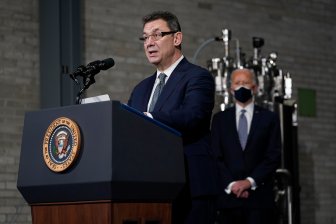[ad_1]
The impact of the ongoing COVID-19 pandemic on Montreal’s downtown core is no secret. The office towers remain mostly empty as work from home directives remain in place, restaurant dining rooms are shuttered and streets have been devoid of the usual throng of students and tourists for months on end.
Unlike other neighbourhoods, people live the “downtown lives because it attracts people,” said Richard Shearmur, Director of McGill School of Urban Planning, detailing the particular challenges facing the city’s heart centre.
While vaccination offers the promise of better days ahead, the threat of a surge in cases linked to COVID-19 variants could slow down efforts to get Montreal back on track.
Preliminary results of a survey conducted among members by the Canadian Federation of Independent Business (CFIB) from April 8 to April 13, indicate businesses owners citywide are very worried.
Close to 70 per cent of respondents said the uncertainty surrounding the third wave, and the possibility of more restrictions and closures is a main concern.
Many businesses currently aren’t operating at full capacity in terms of staffing and revenues aren’t what they should be for this time of year either. Only 28 per cent said they were making above or about about the usual for this time of year, while 8.3 per cent said they had no revenues at all.
A majority (64.3 per cent) of those surveyed in Montreal indicated that emergency relief programs like the Canada Emergency Business Account, Canada Emergency Wage Subsidy and Canada Emergency Rent Subsidy continue to be crucial for the survival of their businesses for the 2021.
Most (85 per cent) also agree that emergency support for businesses should remain until all COVID-19 related restrictions are removed.
Making a comeback
Despite the numerous challenges and uncertainty, Glenn Castanheira the executive director of Montréal centre-ville, the city’s downtown business development corporation (SDC), is hopeful the city can and will bounce back to its pre-pandemic days.
“It’s important to know that right before this pandemic, Montreal was at its peak,” he said. “We were beating records in footfall, in visitors, in tourists, in projects happening and in sales per square foot. So we were booming.”
To achieve it’s role of attracting people, Castanheira believes Montreal has to build on its strengths — namely the city’s economic diversity.
“We are one of the rare downtowns in the world that rely on more than one economy for our downtown,” he said. “We are at the same time the financial district of Quebec, we are also the entertainment district of Quebec, and we are as well, the university district of Quebec.”
Ultimately what it comes down to, according to both Shearmur and Castanheira, is offering people “the best experience possible in downtown.”
Doing so is a responsibility that befalls multiple players.
CFIB Quebec vice-president François Vincent said consumers need to do their part in supporting small businesses when they decide where to do their shopping.
Rather than spending their dollars in big box stores, consumers should favour local retailers.
“It will have a positive impact on the local economy,” he said.
Retailers of course have a role to play by creating better in-store experiences. Shearmur cited Apple stores as an example of a place where people go not only to buy phones but to take in their surroundings.
“You know, it’s the experience of the Apple store … as much as the objects,” he said. “More and more retail is going to become like that, often accompanied by an online presence.”
According to Shearmur, downtown retailers have the added challenge of having to compete against suburban shopping centres. He says malls like Quartier Dix30 on the south shore, are becoming more like leisure centres with their cinemas and fitness areas.
“Pardoxically … places like Dix30 are trying to recreate an urban environment,” he said. “They’re trying to recreate patios and recreate restaurants but out onto the the street.”
Shearmur believes that part of making Montreal a more attractive destination means allowing for more activities to take place on the street, in a safe environment.
Pedestrianizing downtown Montreal
Both Shearmur and Castanheira envision a future downtown that is more pedestrianized, a place where people can gather and linger.
Shearmur pointed to European cities, big and small, that have successfully implemented pedestrian cores.
“I think that this is happening and Montreal needs to get on board,” he said. “Even New York has pedestrianized Times Square for crying out loud”
Castanheira, for his part, spoke of adopting a hybrid model where some streets could be closed off only some of the time, like on weekends.
“Pedestrianization does not mean demonizing cars and having a closed off street doesn’t mean that,” he said.
Recent attempts, however, to close off streets in various parts of the city over the summer — as part of COVID-relief measures — weren’t always greeted favourably.
Some business owners complained about the loss of parking spaces for their clients and difficulties in getting supplies and merchandise delivered.
Castanheira argued that the question that needs to be asked is “how can we greet as many people as possible?”
“With the street that is open to traffic, we’re limiting how many people can actually be on the street.”
While there might be some resistance to change, Casthanhiera said businesses in the downtown core are amenable to the idea.
“In our case, our businesses, over 85 per cent of our businesses want some form of pedestrianization, hybrid, part time, full time, one of them,” he said, adding that sentiment was echoed by consumers as well.
“The overwhelming majority of them say that what they enjoyed most of coming downtown is being able to enjoy certain streets that are closed off to traffic so that they can enjoy the full experience of downtown, and that includes customers that come by car.”
Both Shearmur and Castanheira, however, insist that proper planning is a must to ensure a successful project.
“We’re talking about a surgical a pedestrianization of certain areas, with obviously solutions for pickup and drop offs on intersections,” Castanheira said.
“What’s important is that we make decisions based on facts and not just opinions or not rapid decisions taken in the heat of the moment because there’s a pandemic, we really need to, you know, let the dust settle and make decisions that are based on data, on facts and that are worked with different partners.“
In the longer term, Shearmur sees the possibility of building multilevel car parks in the periphery to accommodate those with cars.
While public transit should be the preferred way to travel to the city centre, Shearmur pointed out that the REM, Montreal’s future light-rail electric train network, won’t service all areas.
The network, once completed, will include 67 km of tracks that will link Montreal, the south shore, the West Island and the north shore and provide a direct link from the airport to the city’s downtown core.
In December, officials announced two new REM lines for Montreal’s north and east ends. The expansion will see an additional 32 kilometres and 23 stations added to the Réseau Express Métropolitain (REM) with construction set to begin in 2023.
Despite the extension, residents in the north east end of the island in Rivières-des-Prairies are feeling left out, as the rapid-transit network is not expected to serve their neighbourhood.

Nonetheless, the REM will make downtown more accessible to more people coming from further afield.
“So I think downtown has got to think about remaking itself into a real destination for people across the metropolitan area,” Shearmur said.
That, to a certain extent, will depend on the flexibility of the services offered.
“If you want to actually go and have a good meal, you can hop on the REM and go downtown. And crucially, and this will depend on how much it costs and on the timing, you want to be able to get back home again.”
“You don’t want the REM to stop at nine o’clock at night. You want it to actually stop at two in the morning or three in the morning. And that’s something that I think the city of Montreal and the REM have got to think about.”

Public transit offerings will also be an important factor when office tower employees return to work.
The return of the office worker
Both Shearmur and Castanheira are confident the majority of employees will in fact return to the office, once public health regulations allow.
“We’re speaking with big employers and the employees really want to come back to work,” Castanheira said.
Shearmur anticipates an 80 per cent return, meaning that people will return to the office about 80 per cent of the time.
Some employees might work from home in the morning and then drop in later for an afternoon meeting, he said.
That could impact the rush to and from the city, whether by car or public transit. The rush hour could see less commuters, with traffic whether by car or public transportation, spread out through the day.
Shearmur also believes that companies will look centralize their operations and cut down on overall office space — a trend that was on the rise before the onset of the health crisis.
“Many office spaces before the pandemic, they were already reducing their square footage because of what’s called hot desking. People would come in, put their laptop down at work and then take it up and go somewhere else.” he said.
“So offices, were more and more, even before the pandemic, being used for meetings, for for maybe socializing. But quite a lot of work was already being done elsewhere, partly in cafes, partly at home.”

Ultimately, the reduction in the use of office space by bigger companies, may end up creating opportunities for smaller players by freeing up secondary office space in buildings deemed less desirable.
That could bring down rents in those spaces, allowing for artists or startups, which might not have considered a downtown location, to move in bringing diversity and a renewed vitality.
Montreal also announced subsidies in March aimed at helping startups relocate in the city centre as part of a wider initiative to kickstart the downtown.
Montreal and the Quebec government are spending a combined $25 million, and the Montreal Metropolitan Chamber of Commerce is injecting another $8.5 million into efforts to draw visitors and workers back to the city this summer.
“We all have the will of making downtown friendly and fun and exciting again,” Montreal Mayor Valérie Plante said at the time, pointing out how different interests were working together towards a common goal.
The money will go towards funding various initiatives from the creation of outdoor co-working spaces and other urban furniture, to help festivals and circus arts develop programming and street performances to prolong the season. Parking in the downtown area will remain free on weekends until Labour Day to increase accessibility and for the second year in a row, permits for restaurant wanting to install a terrace will be just $50.
If all goes according to plan, summer in the city may offer a glimpse into the downtown of the future.
© 2021 Global News, a division of Corus Entertainment Inc.
[ad_2]

